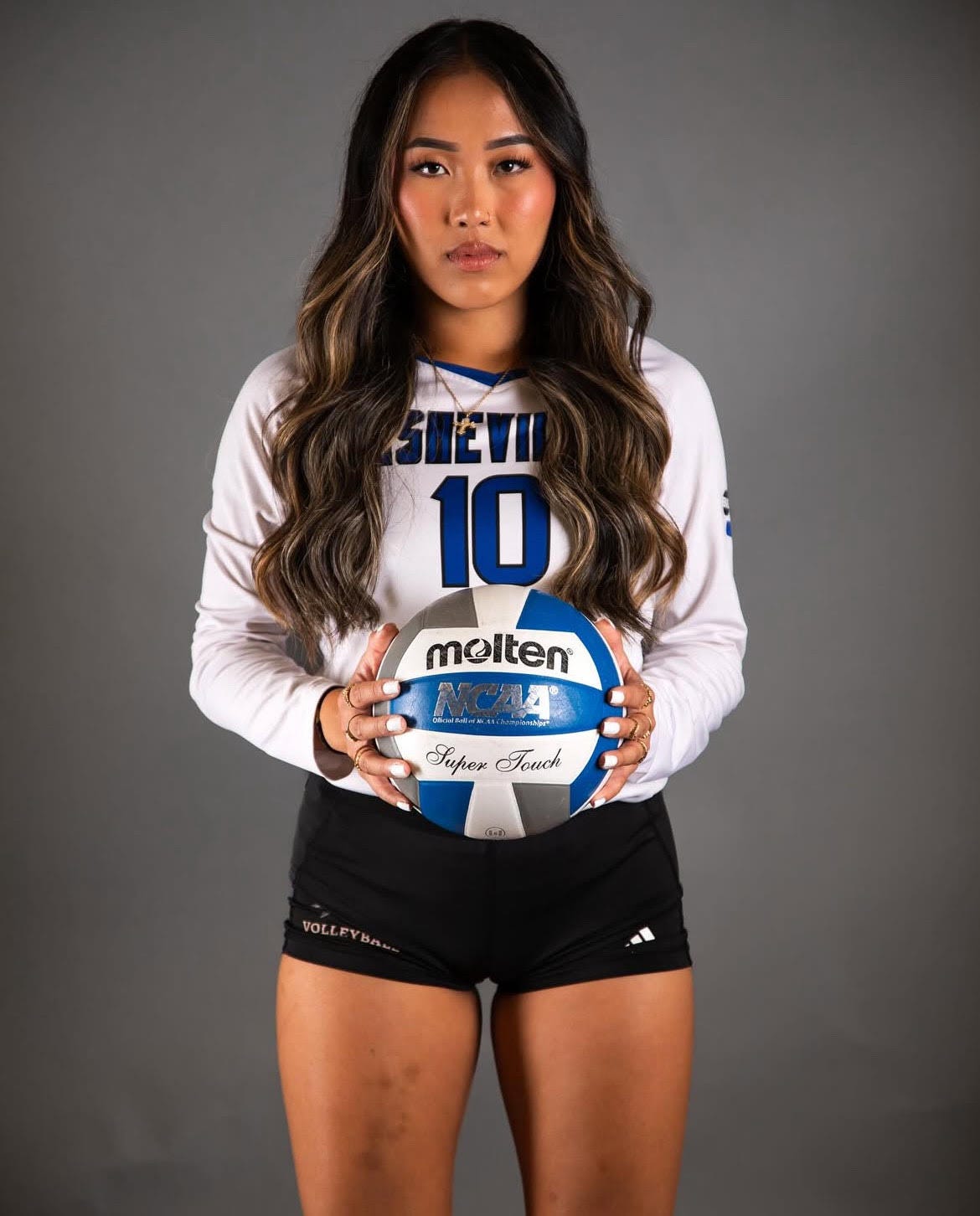The NIL Blueprint for Olympic/non-revenue Student-Athletes
Supporting athletes like Michelle Thao is the future - and it's got nothing to do with revenue sharing.

Only 9 days left to register for the NIL/mba, beginning April 16th. Use the link below to secure a spot today at a $250 early registration discount. The guest faculty for these sessions include: Blake Lawrence (Opendorse), Solly Fulp (Learfield), Darren Heitner (HEITNERLEGAL), Darien Harris (Michigan State University), Spencer Harris (House of Victory / USC Athletics.)
Email me if you have questions or schedule a call with me to discuss the NIL/mba.
Meet Michelle Thao
Michelle Thao…
Is a good volleyball player, appearing in all 23 matches for the UNC Asheville Bulldogs last season.
Is a good student, earning Academic All-District®.
Has a good social media following with about 4,000 followers on Instagram and another 12,000 on TikTok.
Michelle is the quintessential Olympic sport student-athlete. Like 160,000 other DI athletes like her - the non-football/basketball athletes - she won’t receive a dime from revenue sharing or Collectives. Instead, she is in pursuit of authentic NIL partnerships.
On March 5th - the day after the first of my three NIL Workshops with UNC Asheville - Michelle emailed this to me: “I wanted to let you know that I just reached a huge NIL deal right after the Zoom meeting and I am so excited for more, hope you can continue to help!”
I am excited for Michelle of course. She deserves this kind of success 100 times over. But am I surprised? Absolutely not.
We know the NIL blueprint that works for Olympic/non-revenue student-athletes to secure authentic NIL deals.
The Data Behind the Blueprint
It’s not just four years of trial and error.
In the Spring of 2024, I surveyed over 700 DI student-athletes, selected based on whether they had received NIL education from their school or a third party.
Then isolating student-athletes who had secured at least one NIL deal, I surveyed them about the content of the NIL education they’d received (financial literacy, Collectives, regulations, and 10+ other areas of focus.)
Based on that data, I identified the content that had a positive correlation to landing a first/next partnership or had a negative/no correlation to pursuing NIL or securing an NIL partnership.
The data supports that there are three elements of NIL education lead to a student-athlete’s success:
Building a personal brand for NIL
Establishing an NIL-centric social media presence
Learning to market themselves
Read below for detail on the blueprint.
[Curriculum that includes elements like financial literacy, regulations, and life skills has value - and in other workshops and courses, I teach that too. But that curriculum lacks relevance and the tangible steps toward helping student-athletes secure their first and next authentic NIL deal.]
Part 1: Building a Personal Brand for NIL
In our 2024 NIL Research Poll, student-athletes who featured personal characteristics in addition to their sport were 12x more likely to land their first NIL deal.
So how do student-athletes build a personal NIL brand?
Step 1: Taking a Personal Inventory
Student-Athletes should start with three areas:
Strengths: What do teammates, coaches, or friends say the student-athlete is good at?
Values: These are the beliefs that guide the student-athlete’s choices.
Interests: These are where the student-athlete’s passions live. Sharing their interests attracts like-minded communities and brands.
When athletes highlight only their sport, they blend in. When they bring in their personality and passions, they stand out.
Step 2: Knowing an Audience
The next step is understanding who the student-athlete is trying to reach—fans, brands, teammates, or potential collaborators.
Student-Athletes should ask themselves:
Who follows me now?
What content gets the most engagement?
What are some of my audiences interests?
Once a student-athletes knows this, they can build content and messaging that connects.
Step 3: Crafting a Core Message
This is the one simple statement that defines the student-athlete’s brand.
Here are three proven elements to include:
Who you are
What you stand for
What people can expect from you
Example: “As a college gymnast, I strive for balance on and off the mat, championing mental wellness alongside physical excellence.”
Be clear. Be authentic. And be consistent.
This isn’t about manufacturing an identity. It’s about revealing who you are, why it matters, and how that story connects to your audience and potential brand partners.
Part 2: Establishing an NIL-Centric Social Media Presence
Social media is where 85% of authentic NIL happens. But it’s not just about follower count.
Our NIL Research Poll found that student-athletes with fewer than 10,000 followers—those in the micro-influencer range—are the most in-demand by brands. Why? Trust and engagement. Not just reach.
Here’s how to build a social media presence that attracts partnerships:
Step 1: Learn the Rules of the Road
Before anything else, student-athletes should make sure they:
Review their school’s NIL and social media policies
Check their state’s NIL disclosure laws
Follow FTC endorsement guidelines
Brands want partners who understand the rules.
Step 2: Choose the Right Platforms
TikTok and Instagram dominate for authentic NIL. They win on:
Engagement
Visual storytelling
Brand activity
Analytics and reach
Student-Athletes should choose one to focus on, but ideally be active on both.
Step 3: Optimize Your Profile
Student-Athletes should think of their social profile like their business card.
Make sure it includes:
A clean, clear profile pic and header
A short bio that says what they’re about
Contact info for brands
Step 4: Post with Purpose
Create content in four key themes:
Athletic success: game clips, highlights, performance
Behind-the-scenes: practices, workouts, team travel
Personal interests: hobbies, causes, life off the field
Community: volunteer work, mentoring, social impact
This variety tells the athlete’s full story. That’s what attracts brands.
Step 5: Engage with Brands
NIL doesn’t just fall into the laps of most student-athletes. They need to be strategic:
Identify brands that align with their values and audience
Follow brands that interest them on social media
Comment and share their posts
Mirror their tone and content style in their own posts
This builds familiarity—and increases a student-athlete’s odds when they reach out for a deal.
Finally, student-athletes need to grow their following by focusing on:
Hooks: grab attention in the first few seconds
Reels & Stories: short-form content performs best
Consistency: post regularly with a similar look and feel
If they're consistent, aligned, and strategic, their social media becomes their NIL storefront.
Subscribe to NIL/edu for $5 per month to unlock the rest of this newsletter, including:
Create Sales Materials
Research and Identify the Right Brands
Personalize Your Pitch
Follow Up Like a Pro
You’ll get access to this edition, 4 newsletters per month, and all past subscriber-only content.
Part 3: Learning to Market Themselves
Most first-time NIL deals happen because student-athletes initiate them.
According to our 2024 NIL Research Poll, 8 out of 10 student-athletes who landed an NIL deal did so through direct outreach.
Here’s how a student-athlete can take control of their NIL marketing:
Step 1: Create Sales Materials
Every athlete should have these three tools:
Message Templates: Short intro messages for DMs, emails, and LinkedIn
Social Media Kit: A one-page overview of who they are, their social reach, audience demographics, and interests
Pitch Deck: A 10-slide deck including their story, value proposition, social stats, partnership proposal, and contact info
These materials signal professionalism. And they make it easy for brands to say yes.
What do brands care about?
Engagement rate: Brands want interaction, not just followers
Conversions: They want sales, traffic, or inquiries
Brand alignment: They want authentic voices, not generic influencers
Athletes average 5.5% engagement—nearly triple that of traditional influencers. That stat alone can land a deal if you know how to present it.
Step 2: Research and Identify the Right Brands
Use tools like:
Google and Yelp for local businesses
LinkedIn to find marketing or partnership leads
Chamber of Commerce directory for small business contacts
Student-Athletes should choose brands that:
Share their values
Speak to their audience
Have a social presence they can complement
Step 3: Personalize Your Pitch
Student-Athletes should not send the same message to every brand. Customize:
The intro
How their audience matches theirs
What specific posts or content they will create
What the deliverables would be (stories, posts, videos)
Step 4: Follow Up Like a Pro
Most deals don’t happen after one message.
Use these tips:
Be persistent: Send a second and third follow-up
Add value: Share a new content idea or stat
Show enthusiasm: Let your passion shine through
Professional follow-up separates a student-athlete from other athletes who don’t know how to close.
Bill Carter is a leading NIL educator and consultant and founder of Student-Athlete Insights. He provides digital courses, live workshops, and consulting to help High School & College Athletes to turn their NIL into income. Bill can be contacted at bill@studentathleteinsights.com.


